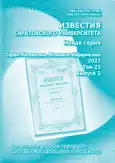Investigation of the need to use the variable value of the ballistic coefficient when modeling the trajectory of the bullet in the shooter simulator
- Authors: Egorov S.F.1, Vdovin A.Y.2
-
Affiliations:
- Udmurt Federal Research Center of the Ural Branch of the RAS
- Kalashnikov Izhevsk State Technical University
- Issue: Vol 23, No 2 (2023)
- Pages: 253-263
- Section: Articles
- URL: https://journals.rcsi.science/1816-9791/article/view/250847
- DOI: https://doi.org/10.18500/1816-9791-2023-23-2-253-263
- EDN: https://elibrary.ru/IXKNHK
- ID: 250847
Cite item
Full Text
Abstract
About the authors
Stanislav F. Egorov
Udmurt Federal Research Center of the Ural Branch of the RAS34 Tat’iany Baramzinoi St., Izhevsk 426067, Russia
Aleksey Yu. Vdovin
Kalashnikov Izhevsk State Technical University7 Studencheskaya St., Izhevsk 426069, Russia
References
- Munoz J. E., Pope A. T., Velez L. E. Integrating biocybernetic adaptation in virtual reality training concentration and calmness in target shooting // Physiological Computing Systems. Cham : Springer, 2019. P. 218–237. (Lecture Notes in Computer Science, vol. 10057). https://doi.org/10.1007/978-3-030-27950-9_12
- Labr M., Hagara L. Using open source on multiparametric measuring system of shooting // 2019 International Conference on Military Technologies (ICMT). Brno, Czech Republic, 2019. P. 1–6. https://doi.org/10.1109/MILTECHS.2019.8870093
- Bogatinov D., Lameski P., Trajkovik V. Firearms training simulator based on low cost motion tracking sensor // Multimedia Tools and Applications. 2017. Vol. 76, iss. 1. P. 1403–1418. https://doi.org/10.1007/s11042-015-3118-z
- Gudzbeler G., Struniawski J. Functional assumptions of «Virtual system to improve shooting training and intervention tactics of services responsible for security» (VirtPol) // Conference on Photonics Applications in Astronomy, Communications, Industry, and High Energy Physics Experiments (Wilga, Poland). 2017. Vol. 10445, Art. 104456M. 6 p. https://doi.org/10.1117/12.2281622
- Gudzbeler G., Struniawski J. Methodology of shooting training using modern IT techniques // Conference on Photonics Applications in Astronomy, Communications, Industry, and High Energy Physics Experiments (Wilga, Poland). 2017. Vol. 10445, Art. 104456L. 6 p. https://doi.org/10.1117/12.2281618
- Fan Y. C., Wen C. Y. A virtual reality soldier simulator with body area networks for team training // Sensors. 2019. Vol. 19, iss. 3. Art. 451. https://doi.org/10.3390/s19030451
- de Armas C., Tori R., Netto A. V. Use of virtual reality simulators for training programs in the areas of security and defense: A systematic review // Multimedia Tools and Applications. 2020. Vol. 79. P. 3495–3515. https://doi.org/10.1007/s11042-019-08141-8
- Fedaravicius A., Pilkauskas K., Slizys E., Survila A. Research and development of training pistols for laser shooting simulation system // Defence Technology. 2020. Vol. 16, iss. 3. P. 530–534. https://doi.org/10.1016/j.dt.2019.06.018
- Maciejewski M., Piszczek M., Pomianek M., Palka N. Optoelectronic tracking system for shooting simulator — tests in a virtual reality application // Photonics Letters of Poland. 2020. Vol. 12, iss. 2. P. 61–63. https://doi.org/10.4302/plp.v12i2.1025
- Taylor P., Piszczek M., Pomianek M., Palka N. Dispatch priming and the police decision to use deadly force // Police Quarterly. 2020. Vol. 23, iss. 3. P. 311–332. https://doi.org/10.1177/1098611119896653
- Maciejewski M., Piszczek M., Pomianek M., Palka N. Design and evaluation of a SteamVR tracker for training applications – simulations and measurements // Metrology and Measurement Systems. 2020. Vol. 27, iss. 4. P. 601–614. https://doi.org/10.24425/mms.2020.134841
- Егоров С. Ф. Стрелковый тренажер «Ингибитор»: функциональная схема программного обеспечения // Интеллектуальные системы в производстве. 2019. Т. 17, № 2. С. 19–29. https://doi.org/10.22213/2410-9304-2019-2-19-29
- Егоров С. Ф., Вдовин А. Ю., Шелковников Ю. К. Стрелковый тренажер «Ингибитор»: программное обеспечение баллистики оружия калибра 5.45 // Интеллектуальные системы в производстве. 2021. Т. 19, № 2. С. 50–61. https://doi.org/10.22213/2410-9304-2021-2-50-61
- Егоров С. Ф., Вдовин А. Ю., Коробейникова И. В., Петухов К. Ю., Сяктерев В. Н. Стрелковый тренажер «Ингибитор»: математическое обеспечение баллистики оружия калибра 7.62 // Интеллектуальные системы в производстве. 2021. Т. 19, № 3. С. 121–133. https://doi.org/10.22213/2410-9304-2021-3-121-133
- Таблицы стрельбы по наземным целям из стрелкового оружия калибров 5.45 и 7.62 мм. Москва : Воениздат, 1977. 264 с.
- Егоров С. Ф., Казаков В. С., Коробейников В. В. Стрелковый тренажер на общедоступных компонентах // Интеллектуальные системы в производстве. 2011. № 1 (17). С. 182–185. EDN: NXVFQB
- Егоров С. Ф., Коробейников В. В., Казаков В. С. Информационно-измерительные системы оборонного назначения: стрелковые тренажеры и электронные мишени // Механика и физико-химия гетерогенных сред, наносистем и новых материалов : материалы научных исследований. Ижевск : Ин-т механики УрО РАН, 2015. С. 328–349. EDN: ULMFGF
- Егоров С. Ф., Шелковников Ю. К., Осипов Н. И., Кизнерцев С. Р., Метелева А. А. Исследование оптико-электронных регистраторов точки прицеливания стрелковых тренажеров // Проблемы механики и материаловедения. Труды Института механики УрО РАН. Ижевск : Ин-т механики УрО РАН, 2017. С. 227–248. EDN: ZFJKKF
- Ермолаев С. И., Комаров Л. Б., Чурбанов Е. В. Внешняя баллистика. Ленинград : [б. и.], 1958. 716 с.
- Коновалов А. А., Николаев Ю. В. Внешняя баллистика. Ижевск : Изд-во Ин-та прикладной механики УрО РАН, 2003. 192 с.
- Гудич И. Г., Козлитин И. А. О расчете баллистических коэффициентов пуль и снарядов // Электронные информационные системы. 2015. № 4 (7). С. 81–88. EDN: VLDHED
- Хайков В. Л. Математическая модель внешней баллистики снайперской винтовки Драгунова на основе оценки баллистических коэффициентов по данным таблиц стрельбы // Вопросы оборонной техники. Серия 16: Технические средства противодействия терроризму. 2017. № 11–12 (113–114). С. 16–23. EDN: ZVZGMF
- Chepkov I. B., Hurnovych A. V., Lapyts’kyi S. V., Oliiarnyk B. O., Trofymenko V. H., Maistrenko O. A. Method of Conversion for the Ballistic Coefficient of Bullets // Strength of Materials. 2020. Vol. 52. P. 419–422. https://doi.org/10.1007/s11223-020-00193-8
Supplementary files










